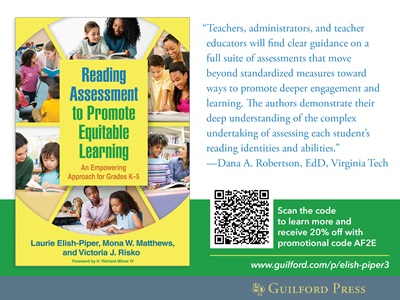
It’s back-to-school time and many teachers are once again faced with administering universal screeners, benchmark assessments, and statewide standardized tests, leaving them wondering if there is any time to teach
We believe that traditional assessments are more than just time consuming; they are failing students by making teachers invisible in teaching and learning. These kinds of assessments lead to sorting and labeling students without noting genuine student progress preventing teachers from using their expertise and experience to support their students’ literacy learning.
Our upcoming ILA Webinar Reading Assessments That Promote Equitable Learning, will explore ways that assessments can honor the many assets that students bring to their learning, leveraging these capabilities to support their literacy development.
Drawing on our years of research in classrooms and our interviews with teachers and students, we designed this approach to reading assessment to put students and teachers alike front-and-center in the assessment process to ensure their efforts are fully visible. We believe that assessment can be a tool for equitable learning if it provides a means for teachers to get to know who their students are and allows them to plan and implement literacy instruction that helps all of their students grow as readers, learners, and thinkers.
The four principles of reading assessment
Principle 1: Reading assessment must occur through an equity mindset that promotes respectful teacher–student relationships, embraces students as active partners, and builds on students’ strengths. Students who trust their teachers are more likely to engage in self-analysis, and positive teacher–student relationships increase students’ academic success and satisfaction with school.
Principle 2: Reading assessment must ensure the visibility of teachers and students in the assessment process by foregrounding who students are and what they know and can do as well as the professional expertise of teachers. When assessment is guided by thoughtful teachers who leverage students’ histories and lived experiences, they can support learning for all.
Principle 3: Reading assessment must be embedded in daily instructional and learning activities wherein it is planned with instruction and can offer timely and useful data. Assessments embedded in authentic learning experiences and thus, become a forethought and not an afterthought.
Principle 4: Reading assessment must account for reading’s complexity by including multiple forms and functions that account for the whole child. Assessments focus on cognitive processes and personal, social, and cultural influences.
Seven areas of assessment
Our approach to reading assessment addresses the following seven areas:
1. Understanding students’ funds of identity. These assessments capture how students and teachers view themselves and the identities they have acquired. Information gained from these assessments support instruction that is responsive to students’ diverse histories and capabilities.
2. Building trusting relationships. Assessment as a humanizing process is demonstrated in these assessments; students’ interests, histories, and self-analysis are prioritized over test scores. Teacher–student trusting relationships are formed as they each share their views of themselves and others.
3. Using student talk to assess reading comprehension. As students use their oral language to talk about the texts they are reading, they are advancing their own learning and making visible what they know and understand. Such opportunities provide information that can guide instruction.
4. Assessing readers’ text comprehension. Central to these assessments is the importance of capturing the resources (e.g., information sources, cultural and linguistic histories) that students bring to their learning and making visible the strategies students are applying to make sense of texts and to construct new knowledge.
5. Assessing constrained skills within the big picture of reading. Constrained skills, such as phonemic awareness, phonics, and fluency, are measured within authentic contexts and in combination with unconstrained skills, such as the use of language and meaning to support vocabulary development and text comprehension. Teachers gain knowledge of students’ strategic use of multiple sources of information to guide word learning.
6. Using assessment to support students’ development of agency. An important goal of education is to help students take more responsibility for their learning. By understanding how much choice, ownership, and voice students have related to their learning, teachers can gather valuable information to plan instruction and support student learning.
7. Starting with students’ strengths. Assessments should focus on making visible the knowledge, skills, and resources that students already possess and support teachers’ use of those capabilities to support and enhance learning.
Join us live for our upcoming ILA Webinar
To learn more about this new approach to equitable assessment, join us for our ILA Webinar Reading Assessments That Promote Equitable Learning on September 12, 5:00–6:30 p.m. ET.

We explore all of this material in greater detail and our assessments are further developed and elaborated upon in our book Reading Assessment to Promote Equitable Learning from Guilford Press, who is graciously offering 20% if you use the code AF2E when purchasing.
Laurie Elish-Piper is distinguished teaching professor of literacy education and interim executive vice president and provost at Northern Illinois University. She previously served as dean of the college of education and director of the Jerry L. Johns Literacy Clinic where she taught courses in literacy assessment.
Mona W. Matthews is professor emerita in the Department of Early Childhood and Elementary Education at Georgia State University. Her research appears in top-tier journals, and she has held numerous leadership positions in professional organizations.
Victoria J. Risko, professor Emerita, Vanderbilt University, focuses on teacher education and supportive learning environments for students experiencing reading difficulties. Risko was the 2011–2012 president of the International Reading Association (now ILA). Among her publications are Be That Teacher! Breaking the Cycle of Struggling Readers with Doris Walker-Dalhouse and Professional Learning in Action with Mary Ellen Vogt. A member of the Reading Hall of Fame, she has received awards for distinguished teaching and research.
Disclaimer: The viewpoints expressed in blog posts on this website are those of the individual writers and do not necessarily reflect the views of ILA. We have taken reasonable steps to ensure the accuracy of the information contained in blog posts but do not warrant the accuracy or completeness of such information.